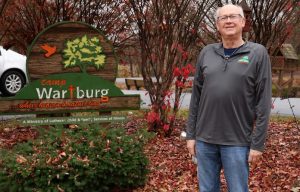New vision for SWIC-Red Bud
The Southwestern Illinois College campus in Red Bud has offered an array of education needs for locals since 1985 when it first welcomed over 300 students.
While the figure naturally ebbs and flows over time, enrollment at SWIC’s Red Bud campus has been on the downturn for several years now, boasting just 38 students in attendance this spring semester.
Though enrollment is at an exceptional low, SWIC Executive Director of Enrollment Development and Institutional Planning Robert Tebbe is hopeful about getting back up to 300 students thanks to a shift in priorities.
Tebbe, along with SWIC Board Trustee Tracy Vallett and recently appointed Red Bud Campus Director Lori Murphy, sat down with this reporter to discuss the college’s recent struggles and its potential change in trajectory.
They noted that currently, enrollment figures at all SWIC campuses seem to be on the rise – save for Red Bud.
Following a height in SWIC enrollment around 2010 – they estimated Red Bud’s campus hosted about 500 students – the college saw a decrease in students across campuses beginning around 2013.
While, as Tebbe said, the situation was being addressed at other SWIC campuses through the 2010s, Red Bud simply didn’t get the same degree of focus.
The decrease in enrollment was further exacerbated beginning in 2020 as the COVID-19 pandemic hit, leading to massive declines in enrollment figures for community colleges in general.
“I think that, pre-COVID, we were on to fix the issue from a scheduling perspective, but COVID happened, and those scheduling issues turned into bigger scheduling issues, workforce needs, lack of faculty, lack of a relationship with the community,” Tebbe said. “And I think we were on to fixing the issue before COVID, but now, I can tell you, institutionally, not just tied to this campus but District 522-wide, fixing this is at the top of the priority list.”
In a Monroe County property tax breakdown for 2020, the multi-county SWIC Community College District 522 amounted to 7 percent of the total property tax distribution.
Tebbe pointed to three particular areas that are a key focus for SWIC administration at Red Bud: transfer degree programming, high-level allied health programming and new career technical education programming.
On top of re-establishing SWIC as an option for those looking to start their college career locally, Tebbe explained the second of these focuses means expanding the campus’s healthcare education offerings.
He noted that the Red Bud campus currently offers certified nursing assistant and licensed practical nurse education but hopes to expand that to registered nurse, medical assistance and rad tech, also working with Red Bud Regional Hospital and other nearby hospitals to gain an understanding of what sort of training prospective healthcare workers need to join the workforce.
As for the career technical education, Tebbe said the campus plans on expanding this programming to include things like HVAC, welding, machining, plumbing and automotive training.
On top of the transfer, allied health and career technical education emphasis, Tebbe said a major focus for the campus is on strengthening relationships with the community.
He pointed to Murphy as a major boon in this respect as someone who has worked in the area as a teacher and, in just the past few weeks as director, has pushed to establish relationships with local schools.
This, Tebbe noted, should help with the campuses’ plan to bring in a greater percentage of graduating students from all nearby high schools.
Also concerning the community focus, Tebbe, Murphy and Vallett spoke about the campus’s role as a sort of hub for the community.
Vallett noted how the campus previously hosted a number of classes and programming for those who weren’t necessarily enrolled, including cutting horse demonstrations, cupcake decorating classes, sewing classes and tutorials for those unfamiliar with computer programs like Microsoft Excel.
Tebbe noted that some community events at the campus – including a butterfly festival – have persisted over the years.
“It sounds like we’ve failed the last few years, but I’m actually somewhat proud of what we’ve been offering the community, whether it’s a trunk-or-treat event or other events, offering services and food pantry to our community,” Tebbe said. “We’ve strengthened our relationship with the chamber of commerce. I don’t want to say it’s all bad. We’ve been committed, we just need to be more committed.”
They generally noted, however, that SWIC’s Red Bud campus would hopefully become a stronger part of the community.
“Red Bud is built on the camaraderie in the community,” Tebbe said. “Not to mention, institutionally, we need a place to generate ideas for the whole district. What better way to do that than try some new things here?”
As for regaining trust among the community, Tebbe pointed to the Red Bud Advantage Program as one already-in-place component that will hopefully see students drawn to the campus.
This program allows students to earn an associate’s degree in arts or science in two years. Tebbe also noted that students would get one class for free if they’re at least a three-quarter-time student.
While Tebbe, Murphy and Vallett placed plenty of focus on the future of the Red Bud campus, they also spoke more about some of the issues the school has faced that students and the community have had to contend with.
Tebbe noted the campus has had a big issue over the years with canceling classes, sending some students to other SWIC campuses instead of helping them keep their education nearby.
He particularly mentioned how this sort of trouble can serve as a hassle for students – especially those hoping to simply get a trade or technical education close to home.
“There’s a lot of travel. Imagine if you’re from this district and you want to get into welding and HVAC. That’s an hour drive to Granite City,” Tebbe said. “So, we really think there’s a niche we can provide these students from a trade perspective.”
Tebbe also hit on a number of other points, regarding the current state of SWIC and the Red Bud campus, noting that the quality of the college’s programming has remained strong while tuition has stayed low even compared to other community college’s.
Again looking to the future, Tebbe placed special emphasis on transfer, allied health and technical education programming along with community trust and relations.
However, to bring campus enrollment back up to 300 students over the next few years, he added there will need to be support from the community as well.
“I also think that in order for this to work, we need buy-in from the community,” Tebbe said. “I don’t want to say it’s a two-way street, but it kind of is. I know we’ve had scheduling issues in the past, but we’re still offering a schedule… We need to get the buy-in back from the community. We need to get it to where students want to come here… We know the impact of that, and that’s why we’re trying to fix it.”
For more information on SWIC’s Red Bud campus, including classes offered, visit swic.edu/about/campuses/red-bud-campus.






